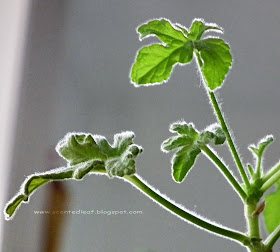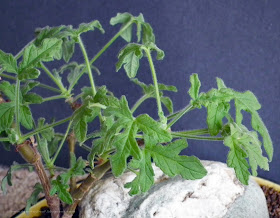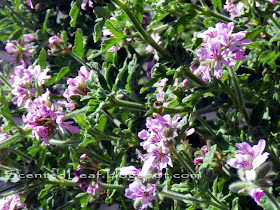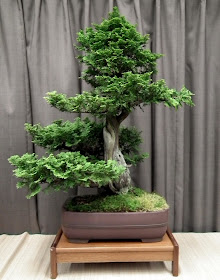 |
| Thuja Bonsai at Taguchi Bonsai Show 2011 |
Native trees are always a plus in growing bonsai since are easier to deal with climate conditions. White cedar is a member of Thuja genus, North American Cedars, ideal for bonsai, featuring deadwood, shari and jin. The photos depict nice specimens featured last spring at Taguchi Bonsai Show 2011. There is no problems wiring branches, either to pruning and pinching - it is a dwarf tree with relative small foliage having an almost pruned look, which do back buds on younger twigs and on the trunk, close to the old branches and has the ability to produce new branching. In the wild, its age can exceed 800 years - so it is one of the oldest trees of North America's woods. Its fibrous bark, red-brown to gray is a plus since it give an old appearance to bonsai.
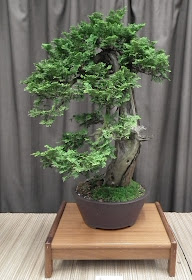 |
| Thuja Cascade Bonsai featured at Taguchi Bonsai Show 2011 |
Accordingly with "Flora of North America: Pteridophytes and gymnosperms" book, published by Oxford University Press in 1993: "Thuja Occidentalis is widely utilized in ornamental silviculture and has more than 120 cultivars and was probably the first North American Tree introduced into Europe (ca. 1566). It is an important timber tree; the wood is used for applications requiring decay resistance. (p.411) "
Eastern White Cedar is a relative fast growing evergreen tree and, when young, it had a pyramidal shape and the shoots are flattened with short points and opposite fan-like leaves. It is very popular in landscaping and in Vancouver's parks and gardens is used as an ornamental tree and hedging plant. Its timber is widely used for log cabins, poles, wooden-ware, paneling and rustic fencing.
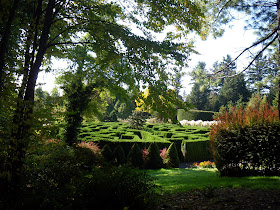 |
| VanDusen Hedge Maze ( up to 3000 Thuia Occidentalis) |
 | ||
| Minter Garden logo contains also Thuja occidentalis hedges |
 | |
| Thuja Occidentalis at Kia Palano Totem-poles park at Capilano Suspension Bridge |
Thuja Occidentalis is also present in Kia Palano Totem-Poles Park from Capilano Suspension Bridge park and nearby Totem-poles and Coast Salish Gateways from Stanley Park.
Similar with other conifers, the foliage, the fruits, the bark and the wood are strongly scented. The essential oil extracted from plant it is widely used in cosmetics products, homeopathic remedies and medicines. The foliage is also rich in Vitamin C and is used to make disinfectants, tincture and teas against constipation and headache.
Thuja Occidentalis is also a beneficial plant for wildlife habitats and source of nutrition for white-tailed deer, hare, squirrels and birds.
